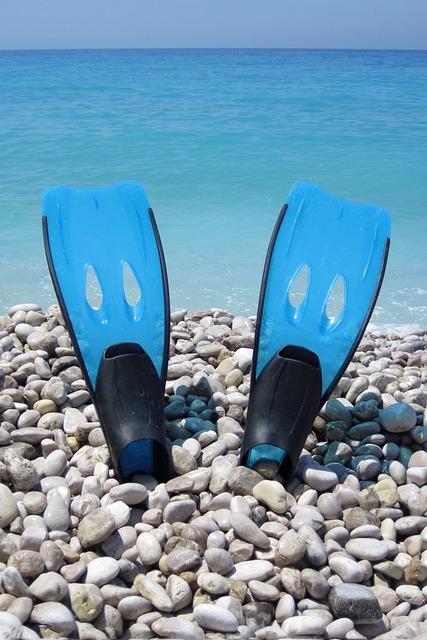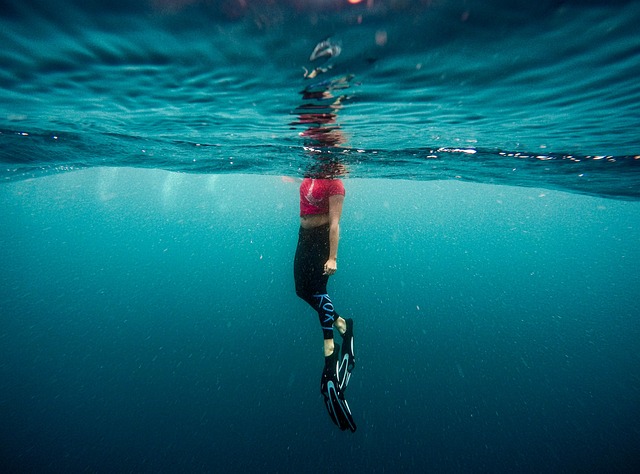Choosing fins for swimming is more than just buying sports equipment, it is an investment in your enjoyment, health and development in the sport. Flippers help improve swimming technique, develop leg strength, and make training more varied and interesting. However, there are many factors to consider before making a choice.
Types of fins

The first place to start is to decide on the type of fins you need. There are many different types of fins:
- Short fins provide a high frequency of leg movements, which is good for endurance training and improving technique.
- Long fins are more suitable for diving and freediving, as they provide a more powerful push in the water.
- Medium fins are a versatile option suitable for a variety of swimming and training styles.
Material
The choice of fin material also plays an important role. The fins can be made of:
- Silicones are soft and comfortable and provide a good fit on the foot.
- Rubbers are tougher, but also more durable.
- Plastics are easy and effective, but may be less comfortable.
- Combination materials – can offer the best combination of comfort, flexibility and durability.
Size and fit
The right size and fit are critical to comfort and swimming performance. Flippers that are too small will be too tight and uncomfortable, while flippers that are too large will easily fall off in the water. Most manufacturers offer detailed size charts to help you find the perfect fit.
- When trying on: Wear the same socks or boots you will be swimming in.
- Manufacturers: Sizes may vary by brand, so always refer to the manufacturer’s sizing charts.
Blade stiffness
The stiffness of the fin blade has a direct impact on swimming performance:
- Soft paddles are good for beginners as they provide ease of movement and do not overload the muscles.
- Stiff paddles are suitable for experienced swimmers, promoting strength and speed.
Additional features
Your swimming style and personal preferences are also important when choosing fins. If you prefer to swim long distances, choose longer and more flexible models. For more intense training in the pool, shorter and stiffer fins are suitable. Modern fins can have various additional features such as adjustable straps for a perfect fit, special inserts to improve hydrodynamics or anti-slip inserts for safety when walking around the pool. Some fins offer additional features that may be useful for certain conditions or preferences:
- Quick Adjustment Systems: Convenient for quick size adjustment, especially when fins are used in different conditions.
- Integrated Fatigue Reduction Technologies: Can reduce muscle strain and reduce leg fatigue.
- Colour and design: Although it doesn’t affect functionality, choosing fins in your favourite colour or design can make swimming more enjoyable.
A guide to choosing fins for all purposes

Given the different situations and conditions in which fins are used, selecting the perfect pair requires a detailed approach. Let’s look at the main scenarios so that you can make the best choice depending on your specific situation.
Pool fins
Short fins are suitable for swimming in the pool. They help to improve technique, leg strength and speed without significantly increasing water resistance. When choosing fins for the pool, you should pay attention to flexibility and comfort. Soft silicone in the foot area will ensure comfort during long training sessions, and quality materials guarantee durability.
Diving fins
Long open-heel fins are ideal for diving and are worn over neoprene boots. They provide a powerful kick and high speed, which is especially important when swimming long distances or against the current. The stiffness of the fin blade should be matched to the diver’s physical capabilities: fins that are too stiff can fatigue quickly, and fins that are too soft will not provide the necessary speed.
Flippers for swimming in the sea
Swimming in the sea often involves crossing currents and longer distances than in the pool. In this case, medium-length universal fins that provide good speed and manoeuvrability are suitable. It is important to consider the material of the fins: for salt water, products made of corrosion-resistant materials are preferable.
Spearfishing fins
Underwater hunting requires maximum silence and the ability to make quick jerks. Spearfishing fins are usually longer and stiffer to ensure efficient movement underwater. Some models are equipped with special channels and holes to improve handling and reduce fatigue. The choice of material is then based on the optimum combination of flexibility and stiffness to provide the necessary thrust power.
Flippers for children
Choosing fins for children, regardless of where they plan to swim – in the sea, river or pool – requires a careful approach that pays particular attention to safety, comfort and adaptation to growing feet. Here are a few key aspects to consider when choosing fins for children:
- Safety first: Flippers should be made of good quality, non-toxic materials. It is also important that they have good buoyancy so that the child can easily surface when needed.
- Precise sizing and adjustability: Children’s feet grow quickly, so fins with an adjustable butt or those that allow for slight size adjustments are ideal. This will allow the fins to “grow” with your child, preventing the need for frequent changes.
- Comfort: A comfortable fit is critical, especially for children. Flippers should not be too tight or cause chafing, as this can discourage your child from swimming. Soft materials in the foot and sole area will help prevent discomfort.
- Bright design: Kids love bright and fun designs. Choosing fins in your child’s favourite colours or featuring their favourite characters can make swimming a more exciting and motivating activity.
- Lightness and handling: For children, it is especially important that fins are light and do not make swimming more difficult. Children’s fins should make movement in the water easier, not more difficult.
- Learning Aspects: Some fins are designed specifically for learning to swim, helping your child to use their legs correctly and improve technique. If your child is just starting their swimming journey, these fins can be particularly useful.
When choosing fins for children, it is important to remember that they play a key role not only in learning to swim, but also in developing a positive attitude towards the sport. Properly selected fins will provide your child with comfort, safety and pleasure from every swimming session, whether in the sea, river or pool.
Budget
Budget is an important factor when choosing fins. While more expensive models may offer better quality and additional features, there are many affordable options that will also perform well. It is important to find the best value for money that will meet your needs and financial capabilities.
Choosing the perfect fins for swimming is a combination of understanding your needs, preferences and conditions of use. By keeping the above aspects in mind, you will be able to make an informed choice that will help improve your swimming experience, making it more comfortable and safer. Don’t forget also the importance of regular care and maintenance of your fins to prolong their lifespan and maintain their excellent performance.
Let reBITme make your next swim fin purchase even more favourable. Enjoy your next purchase!





